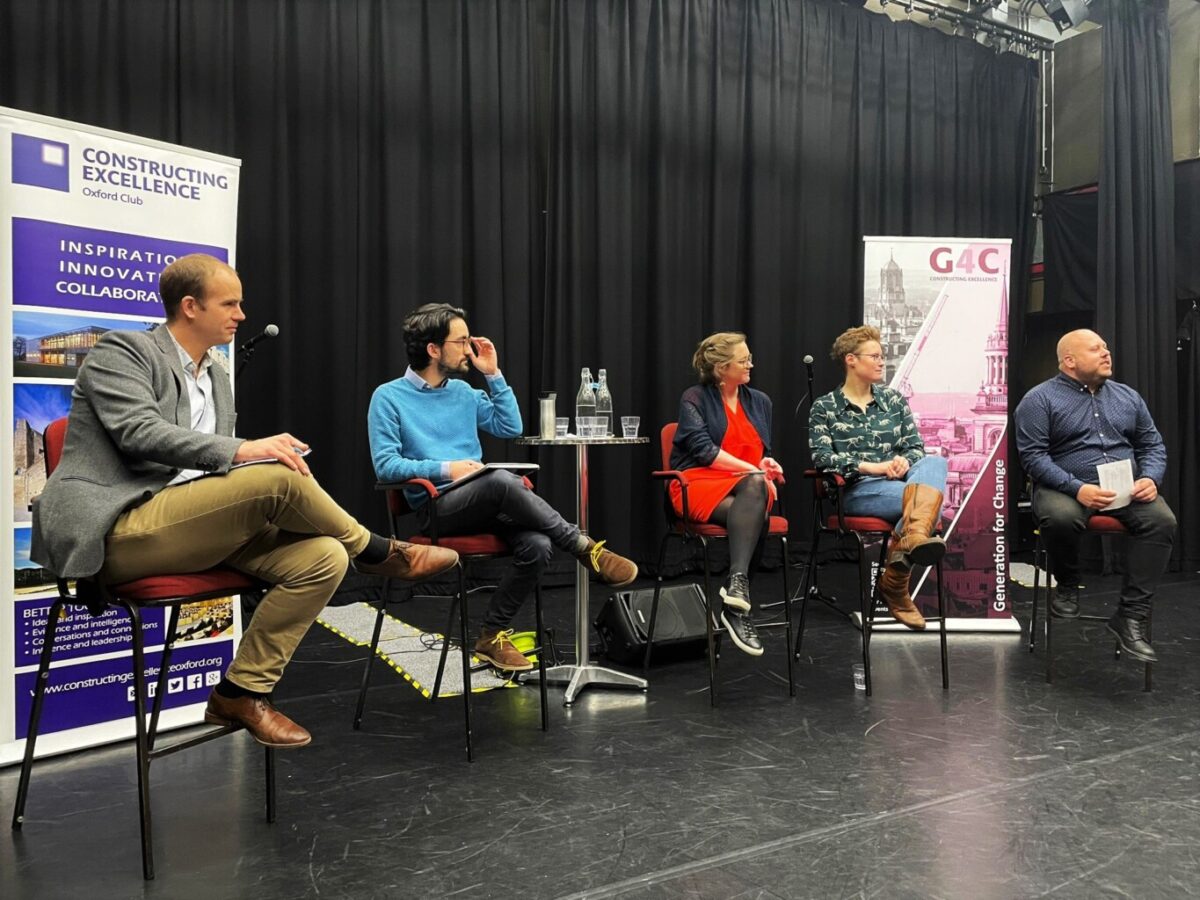
On the evening of Monday 24th April, members of the Constructing Excellence Oxford Club dashed across the city centre, through the April showers, to gather in the café at The Old Fire Station arts venue. The strong turnout gave testament to the interest in the subject amongst the local community of construction professionals – in spite of the poor weather, and disruption to local transport with the closure of Botley Road and disruption to trains between Reading and Oxford Station. As we made our way into the theatre, an expert panel of speakers were assembled on stage – chaired by Jack Strickland – Building Surveyor at Faithful+Gould, and Chair of the Generation for Change Oxford Club. We were delighted to welcome Councillor Anna Railton, representing Oxford City Council as the newly appointed Cabinet Member for Climate Justice and Zero Carbon Oxford. Joined by our technical experts: Chris Hughes, Principal Mechanical Engineer at CBG Consultants Ltd, Laura Baron, Head of Sustainability at Purcell Architects, and William Morris, Conservation Accredited Structural Engineer at Ridge LLP.
We commenced our discussion with the definition of heritage property – which in addition to buildings given individual protection, for example statutory listed buildings, locally listed buildings, and scheduled ancient monuments, may also include buildings without specific historic interest, located within a conservation area. It was noted that non-protected buildings of traditional solid wall construction, typically built before 1919, often share characteristics with their protected counterparts, warranting similar skill and care when undertaking energy improvement and decarbonisation works. It was concluded that the definition of heritage property may in fact describe a sliding scale of built assets: ranging from internationally significant Grade I listed buildings, to rows of unprotected Victorian and Edwardian terraced houses. Their individual significance and custodianship each requiring a differing and unique approach.
To understand the impact that decarbonisation of heritage properties may have on addressing our wider sustainability goals, we looked to a report jointly authored by Grosvenor, The Crown Estate, Peabody, Historic England, and the National Trust titled: Heritage and Carbon: Addressing the Skills Gap. Within this report it is stated that carbon savings equivalent to 5% could be realised through undertaken decarbonisation works in both listed buildings, and unlisted dwellings located in Conservation Areas, based on operational carbon savings. Whilst we tried to avoid the debate on whether there was need to undertake any energy saving interventions to heritage properties, our audience were forthcoming with their thoughts. The continuing decarbonisation of the national grid was fielded as one potential consideration when determining the impact of undertaking decarbonisation works, in addition to the role that the rest of the built environment could play to overcompensate for their poor performance.

Barriers
An obvious challenge when undertaking decarbonisation works to heritage properties is the planning framework and legislative controls which restrict the level of changes that can be enacted.
is the planning framework and legislative controls which restrict the level of changes that can be enacted.
Further discussions on the subject raised common misconceptions and a general lack of knowledge surrounding the statutory protection of heritage assets as a barrier to people attempting to gain consent for undertaking energy improvement works which may be permissible. The need for professional advice, support, and guidance adds an additional barrier to owners wishing to go about undertaking works.
When implementing sustainable technology for the heating generation – the poor performance of the building envelope can limit the effectiveness of systems which operate at lower temperatures and require a much higher degree of thermal efficiency and airtightness.
The supply of electricity to a property is also a significant consideration when undertaking design and specification – as the demand for power supply may exceed the capacity of existing infrastructure.
The works required to enact changes to accommodate sustainable technologies can often place barriers that are difficult to overcome. For example – if the heating distribution pipework and radiators are considered to be of enough significance to warrant protection under the listing.
Finally, the cost of undertaking decarbonisation works is a significant barrier on any property but can become particularly restrictive when dealing with heritage assets which may require a higher quality of craftmanship, or otherwise costlier works to make energy improvements. Despite the rising cost of energy, some of the financial incentives to undertaking works have since been removed. Justification of increased capital costs often require a view of operational savings over the long term – which, whilst potentially suited to some organisations – such as University Colleges or Churches, may not suit every stakeholder’s financial model.

Data Collection
Whilst every heritage property is unique, and will require a unique approach, the most important starting point for any decarbonisation projects is the collection of data. Justification of proposed interventions is reliant on two things: understanding the significance of the heritage asset and understanding the performance of the existing building fabric. For example – understanding that heating distribution pipework and radiators are included under the protection of the listing will rule out any interventions that involve the replacement of these items. This may necessitate the involvement of consultants who specialise in undertaking evaluation of historic significance and the preparation of heritage statements.
Collection of data on the performance of the existing building fabric will assist with the justification of energy improvement works – through demonstration that a measurable improvement in performance will be realised. It is widely accepted that a fabric first approach is the preferred means of prioritising works – ensuring that energy demands are reduced before introducing sustainable technology. This can lead to challenges whereby elements of poorly performing building fabric are of historic significance – for example windows or roof coverings.
Possible Solutions
A potential solution to streamline the planning process for buildings in conservations areas might be to introduce standard guidance for energy improvement works that are considered acceptable to the local authority. Where properties are uniform in their form of construction and significance – it could be possible to provide guidance on a road-by-road basis.
There are additional calls to overhaul the designation categories of listed buildings completely, perhaps with the introduction of an additional Grade III designation. These calls are accompanied by warnings that any changes that further complicate the existing framework may introduce additional barriers to owners of heritage properties from undertaking energy improvement works. Buildings of a traditional form of construction carry risk of the introduction of unintended problems through the implementation of energy improvement measures. For example: the introduction of spray foam insulation which is known to cause issues with the restriction of movement of moisture in properties which can lead to damp and mould issues in addition to the deterioration of timber building fabric. The incorrect application of spray foam insulation has been known to de-value properties and cause problems with mortgage applications.
In a country obsessed with home ownership – perhaps the best motivation for homeowners to undertake decarbonisation works is the impact on their house prices.

Generation for Change (G4C) sits under the umbrella of Constructing Excellence, with a target audience of the next generation for construction professionals. The organisation is currently working on a national project titled: Uncovering Net Zero – breaking down the lifecycle of a construction project and assessing the challenges to decarbonisation at each RIBA stage. Data has been collected through the hosting of online knowledge sharing sessions focussed on each stage of the project lifecycle. The organisation are planning to host a national conference to share the cumulative results. If you are interested in joining G4C please email [email protected], or connect with a local club via LinkedIn.




